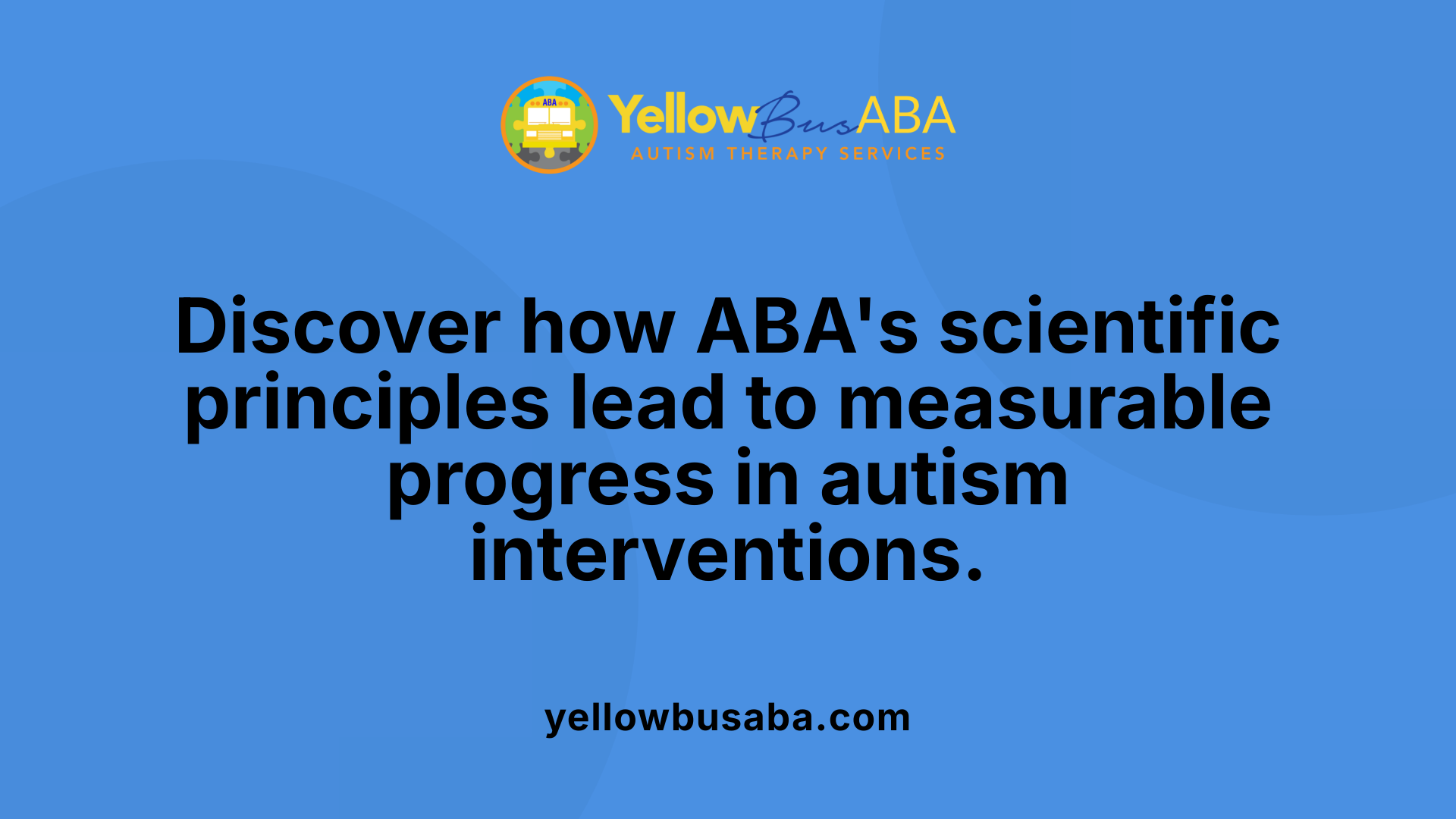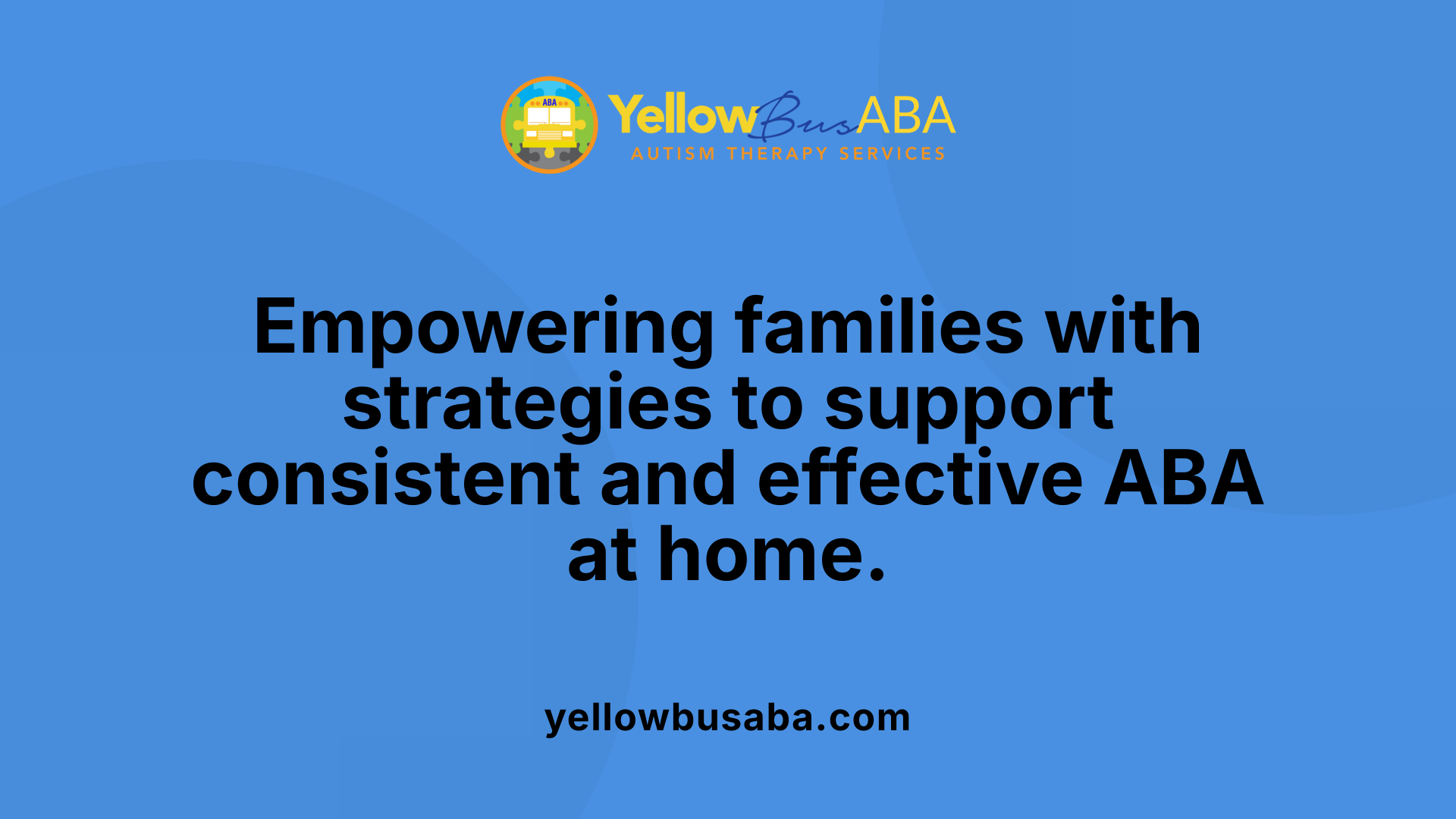Understanding Personalized Autism Support
Effective autism support hinges on personalized, consistent approaches tailored to each individual's unique needs. Applied Behavior Analysis (ABA) therapy exemplifies this, offering a scientifically grounded method that fosters meaningful skill development and behavioral progress. As families and professionals seek supportive pathways, understanding ABA's core principles, application, and accessibility provides clarity about how this therapy fosters independence and quality of life for individuals with autism.
What is Applied Behavior Analysis (ABA) Therapy?
Definition and Principles of ABA
Applied Behavior Analysis (ABA) therapy is a scientific approach that focuses on learning and behavior. It uses evidence-based methods to encourage positive behaviors and reduce those that interfere with learning or daily functioning. ABA operates on core principles such as applied, behavioral, analytic, technological, conceptually systematic, effective, and generalization, ensuring that interventions are consistent, measurable, and practical.
How ABA Supports Individuals with Autism
ABA therapy is widely recognized as an effective, evidence-based treatment for children with autism spectrum disorder (ASD). It helps individuals develop essential skills including communication, social interactions, academic abilities, and self-care routines. By improving these areas, ABA supports greater independence, confidence, and social integration. Progress often shows in intellectual functioning, language use, and daily living skills.
The A-B-C Model in ABA
A central tool in ABA is the A-B-C model:
- Antecedent: What happens before the behavior.
- Behavior: The observable action.
- Consequence: What follows the behavior, influencing whether it tends to increase or decrease.
This model helps therapists understand why behaviors occur and design strategies like positive reinforcement—a reward system to promote beneficial behaviors.
Personalization of ABA Programs
Every ABA program is tailored to the individual. Board Certified Behavior Analysts (BCBAs) conduct detailed assessments to identify specific needs and create goals related to communication, academic skills, play, and daily living. These customized plans make therapy effective and relevant for each learner.
Settings Where ABA Is Delivered
ABA therapy is versatile and can be delivered in multiple settings, including homes, schools, clinics, or community environments. It includes one-on-one instruction or group work based on family preferences and the child’s needs. Ongoing data collection and assessments ensure that goals and techniques adapt over time to provide the best outcomes.
Answer to: What is Applied Behavior Analysis (ABA) therapy, and how does it help individuals with autism?
Applied Behavior Analysis (ABA) therapy is a scientifically grounded approach that uses principles of learning, motivation, and environmental understanding to help individuals with autism develop essential social, communication, and behavioral skills. It involves breaking down complex skills into manageable steps, using techniques like positive reinforcement and the A-B-C (Antecedent-Behavior-Consequence) model to promote desirable behaviors and reduce hindering ones. ABA is highly personalized, with programs designed and overseen by trained professionals such as Board-Certified Behavior Analysts (BCBAs), and can be delivered at home, school, or community settings. The therapy has been supported by extensive research, demonstrating significant improvements in language, social skills, self-care, and independence, especially when started early and conducted intensively. Overall, ABA helps individuals with autism acquire the skills needed for greater inclusion, self-advocacy, and improved quality of life.
The Professionals Delivering ABA Therapy: Qualifications and Roles

Who typically provides ABA therapy, and what qualifications do these professionals have?
ABA therapy is delivered by trained professionals including Board Certified Behavior Analysts (BCBAs), Registered Behavior Technicians (RBTs), and other licensed or certified therapists.
What educational and supervised experience do ABA providers require?
Most professionals hold at least a master’s degree in fields such as psychology, education, or applied behavior analysis. They must complete extensive supervised practical experience—usually between 1,500 and 2,000 hours—to gain proficiency in assessment and intervention techniques essential for ABA.
What certifications do ABA therapists hold?
Certification, such as the BCBA credential, demonstrates mastery of evidence-based practices and ethical standards. Requirements for licensing and certification vary by state, but independently practicing or managing a clinic often mandates these credentials.
What roles do ABA professionals play in assessment and program design?
Qualified professionals conduct detailed behavioral assessments, design tailored ABA programs, set personalized goals addressing communication, social skills, self-care, and behavior management, and continuously track progress. Their expertise ensures that interventions are both effective and responsive to each individual's needs.
In what settings and delivery models is ABA therapy provided?
ABA services can be offered in diverse settings—home, clinics, schools, or community environments—and through various models, including one-on-one, group instruction, or hybrid formats. These delivery options accommodate family preferences and maximize therapeutic impact.
| Role | Educational Requirement | Experience Needed | Main Responsibilities | Typical Settings |
|---|---|---|---|---|
| Board Certified Behavior Analyst (BCBA) | Master’s degree in relevant field | 1,500-2,000 supervised hours | Assessments, designing ABA programs, ongoing monitoring | Clinics, schools, homes, community |
| Registered Behavior Technician (RBT) | High school diploma or higher | Supervised fieldwork under BCBA | Implementing therapy following BCBA-designed plans | Home, school, clinics |
These professionals ensure the delivery of ABA therapy is scientifically sound, personalized, and adaptable across varied environments, guaranteeing children receive the best care tailored to their developmental needs.
The Scientific Basis and Measurable Outcomes of ABA Therapy

How is the effectiveness of ABA therapy measured in individuals receiving this treatment?
The effectiveness of ABA therapy is gauged through continuous and systematic data collection that tracks an individual's progress over time. Behavior analysts, particularly Board Certified Behavior Analysts (BCBAs), develop tailored goals for each learner, focusing on communication, social skills, academics, and self-care.
Evidence base and history since 1960s
ABA has been studied extensively since the 1960s, earning its status as an evidence-based best practice for autism treatment. Decades of research underpin its scientific foundation, demonstrating its capacity to improve intellectual functioning, language development, and daily living skills.
Principles underlying ABA effectiveness
The therapy is built on core principles such as being applied, behavioral, analytic, technological, conceptually systematic, effective, and focused on generalization. This comprehensive framework ensures interventions are consistent, measurable, and grounded in the science of learning and behavior.
Data collection and behavior monitoring techniques
Throughout therapy, data on each behavior is carefully recorded, enabling therapists to monitor trends and patterns. Using the A-B-C model (Antecedent, Behavior, Consequence), practitioners analyze the context of behaviors to understand triggers and outcomes. This aids in crafting precise interventions.
Use of A-B-C framework for assessment and intervention
The A-B-C framework is integral to ABA's assessment and intervention approach. By identifying what happens before a behavior (Antecedent), the behavior itself, and the consequence that follows, therapists can modify environments and apply reinforcement strategies to increase positive behaviors and reduce harmful ones.
Evaluating long-term improvements and generalization
Efficacy is also judged by the learner's ability to generalize skills across settings and maintain gains over time. Progress is continuously reviewed and programs adjusted accordingly, ensuring that improvements are meaningful and sustainable in real-world contexts.
This structured, measurable approach allows ABA therapy to deliver tailored interventions backed by solid scientific evidence, making it a reliable and effective method for supporting learners with autism.
Tailoring ABA Therapy: Customization to Each Child's Needs

How Are ABA Programs Individually Assessed and Crafted?
ABA therapy begins with detailed assessments conducted by Board Certified Behavior Analysts (BCBAs). These assessments identify each child's unique strengths, needs, preferences, and challenges. Based on this thorough evaluation, BCBAs develop personalized ABA programs, ensuring goals and techniques match the child's developmental stage and learning style.
What Types of Goals Do Customized ABA Programs Address?
Personalized ABA goals typically target several skill areas: communication, social interaction, self-care, and academic abilities. For example, therapy might focus on enhancing a child's ability to express needs, recognize social cues, learn dressing and grooming skills, or improve problem-solving in academic tasks. This comprehensive approach helps children develop independence and confidence.
How Is ABA Adapted to Fit the Learner’s Preferences and Environment?
ABA programs are flexible and tailored to each child’s preferences and living context. Therapists integrate the child’s favorite activities and reinforcers to boost motivation and engagement. The environment—whether home, school, or community—also shapes how interventions are delivered to ensure they are relevant and effective.
What Role Does Play and Motivation Have in ABA Therapy?
Play is an important vehicle in modern ABA, used to teach and reinforce new skills naturally. By linking learning to enjoyable activities that motivate the child, therapists enhance participation and accelerate progress. Positive reinforcement strategies reward desired behaviors, ensuring therapy remains encouraging and supportive.
How Does ABA Delivery Vary Across Settings and Formats?
ABA therapy is versatile in delivery formats. It can be provided in one-on-one sessions or small groups, and settings range from homes and schools to community environments. This adaptability helps accommodate family needs, maximize learning opportunities, and apply skills across real-world contexts, supporting generalization.
Core Skills Developed Through ABA Therapy for Autism

Communication Skills Development
ABA therapy plays a crucial role in helping children with autism improve their communication abilities. Through personalized programs designed by Board Certified Behavior Analysts (BCBAs), children learn to express their needs clearly and interpret social cues. This development reduces frustration and enhances their ability to interact effectively with others.
Social Interaction Improvements
Social skills are a primary focus in ABA programs. Techniques such as positive reinforcement encourage children to engage more with peers and adults. This fosters better social integration and confidence, which are essential for building meaningful relationships and participating in community activities.
Self-Care and Independence Skills
ABA programs often teach foundational life skills like dressing, grooming, and other self-care tasks. Mastering these abilities promotes independence, enabling children to handle daily routines with reduced assistance. Such skills empower children to become more self-reliant and confident in their everyday lives.
Behavior Management and Reduction of Disruptive Actions
A core element of ABA therapy is behavior management through the 'A-B-Cs' model — Antecedent, Behavior, Consequence. By applying positive reinforcement strategies, harmful or disruptive behaviors are decreased and replaced with constructive actions. This approach improves overall behavior and supports better learning and social engagement.
Enhancing Adaptive Daily Living Abilities
ABA also focuses on adaptive functioning by targeting skills necessary for academic success and daily living. Through tailored interventions, children enhance their cognitive, social, and practical abilities, which contribute to improved functioning in home, school, and community settings.
Family Engagement: Coaching Parents and Ensuring Consistency

Why is parental involvement important in ABA therapy?
Parental involvement is crucial in ABA therapy because it helps extend learning beyond therapy sessions. When parents actively participate, children receive consistent support, which reinforces new skills and behaviors.
How do therapists coach parents to extend learning at home?
Therapists work closely with parents, teaching them strategies to apply ABA techniques in everyday situations. This coaching empowers parents to reinforce skills like communication, self-care, and behavior management throughout the day.
How is consistency built between therapy settings and home?
Consistency is achieved by aligning therapy goals and strategies across environments. Behavior analysts customize programs that are practical for home use and guide families on applying positive reinforcement and other techniques consistently.
How do families stay informed about therapy goals and progress?
Families are encouraged to ask questions about program objectives, qualifications of providers, and how progress is tracked. Ongoing data collection and assessments allow therapists and parents to review improvements and adjust goals together.
How does collaboration support the generalization of skills?
Collaboration between therapists and families ensures that children practice new skills in diverse settings, helping them generalize these abilities. This teamwork increases independence and social integration by making learning relevant to real-life situations.
Addressing Misconceptions About ABA
What are some common misconceptions about ABA therapy in treating autism?
Many people misunderstand what ABA (Applied Behavior Analysis) therapy truly involves. One common myth is that ABA is punishment-based and focuses on controlling behavior through negative means. In fact, ABA primarily uses positive reinforcement — meaning rewards are given to encourage helpful and desired behaviors, not to punish unwanted actions.
Another misconception is that ABA aims to "cure" autism or change a child's personality. This is not the case. ABA is a supportive tool designed to help children develop communication, social, academic, and daily living skills while respecting their individuality. It seeks to promote independence and confidence rather than erase personal traits.
Some think ABA is rigid, robotic, or one-size-fits-all. Contrary to this, ABA is highly flexible and tailored to each child's needs and preferences. Programs are designed by certified behavior analysts and can include play-based and naturalistic approaches to make learning enjoyable and effective.
People also assume ABA is only for young children. However, ABA techniques can be adapted for individuals of all ages, helping improve communication, social skills, and overall functioning throughout life.
Ultimately, ABA promotes positive growth by encouraging new skills and reducing behaviors that interfere with learning and social integration — not by suppressing personality or forcing conformity.
| Misconception | Reality | Explanation |
|---|---|---|
| ABA is punishment-based | Uses positive reinforcement | Rewards encourage desired behavior, not punishment |
| ABA aims to cure or erase autism | Supports development and independence | Focuses on skills and respects individuality |
| ABA is rigid and the same for everyone | Personalized and flexible programs | Tailored goals and techniques based on individual assessments |
| ABA is only for children | Applicable across all ages | Benefits communication and daily skills at any age |
| ABA suppresses behavior without fostering growth | Promotes positive, helpful behaviors | Encourages independence and social integration |
Access and Insurance: Navigating Availability of ABA Therapy
How accessible is ABA therapy for families, and what factors influence its availability?
Accessibility of ABA therapy has improved substantially in recent years due to federal mandates that require insurance coverage for autism-related treatments. By 2021, all 50 states mandated insurance coverage for ABA, significantly expanding opportunities for families seeking therapy. However, the degree of access can vary based on several factors.
One important factor influencing availability is the type of insurance coverage. Fully insured plans typically comply with state mandates, while self-funded plans regulated by federal law may have different rules or limitations. Additionally, each state’s laws can affect the scope and extent of benefits, such as age caps or service limits.
Medicaid also plays a vital role by covering medically necessary ABA therapy for eligible children under 21, improving access for many families. This coverage often includes detailed assessments and ongoing therapy but varies by state Medicaid program.
Despite these advances, financial and insurance hurdles persist. ABA therapy may be costly, and some insurance providers impose caps or restrictive criteria that could limit access. Families may face coverage denials or complex approval processes.
Resources and advocacy organizations like Autism Speaks support families by providing guidance on navigating insurance claims, understanding benefits, and connecting with local providers.
In summary, ABA therapy is more accessible than ever, thanks to federal and state legislation and Medicaid programs. However, insurance plan details, cost considerations, and regional differences continue to influence how easily families can obtain these vital services.
The Future of Autism Support: Integrating Consistency and Personalization
Ongoing Advances in ABA Techniques
Applied Behavior Analysis continues to evolve with new research enhancing traditional methods. Innovations include the integration of technology for data collection and the development of more engaging reinforcement strategies. These advances aim to improve therapy effectiveness and make sessions more interactive for children.
Growing Emphasis on Tailored Approaches
The trend toward highly individualized ABA programs is gaining momentum. Tailoring therapy to the unique needs of each child ensures that goals are relevant and meaningful. Board Certified Behavior Analysts (BCBAs) use detailed assessments to create customized plans that address specific communication, social, academic, and behavioral targets.
Hybrid and Flexible Delivery Models
ABA services are becoming increasingly adaptable, blending in-home, clinic, and community settings. Hybrid delivery models allow families to choose formats that best fit their routines and preferences. This flexibility helps maintain consistency in learning while making therapy more accessible.
Importance of Consistent Monitoring and Adjustment
Continuous data collection and evaluation enable therapists to adjust goals and methods as a child progresses. This dynamic process ensures that interventions remain effective and aligned with the child's evolving needs. Regular progress reviews foster better outcomes and sustained improvement.
Building Sustainable Support Networks for Families
Effective ABA support extends beyond therapy sessions by actively involving parents and caregivers. Training families to reinforce skills at home helps generalize learning. Additionally, connecting families with community resources and peer support networks creates a stronger, collaborative environment for ongoing success.
Delivering Autism Support That Truly Fits
ABA therapy embodies the promise of personal and consistent support for individuals with autism, grounded in scientific principles and delivered by qualified professionals focused on meaningful progress. By tailoring interventions to each person's unique needs and fostering family engagement, ABA empowers individuals to develop communication, social, and life skills that enhance independence and well-being. Despite challenges in accessibility and persistent misconceptions, ongoing efforts to refine practices and ensure coverage continue to expand the reach and effectiveness of this evidence-based approach. Ultimately, autism support that feels personal and consistent depends on collaboration, expertise, and a commitment to growth—qualities at the heart of ABA therapy.
References
- Applied Behavior Analysis (ABA)
- What Is ABA Service? How It Helps Children with Autism
- How to Become an ABA Therapist - School of Education
- How to Become an Applied Behavior Analyst (ABA) Therapist
- Applied Behavior Analysis (ABA)
- Applied Behavior Analysis (ABA)
- The Top 10 Reasons Children With Autism Deserve ABA



.jpg)

.avif)
